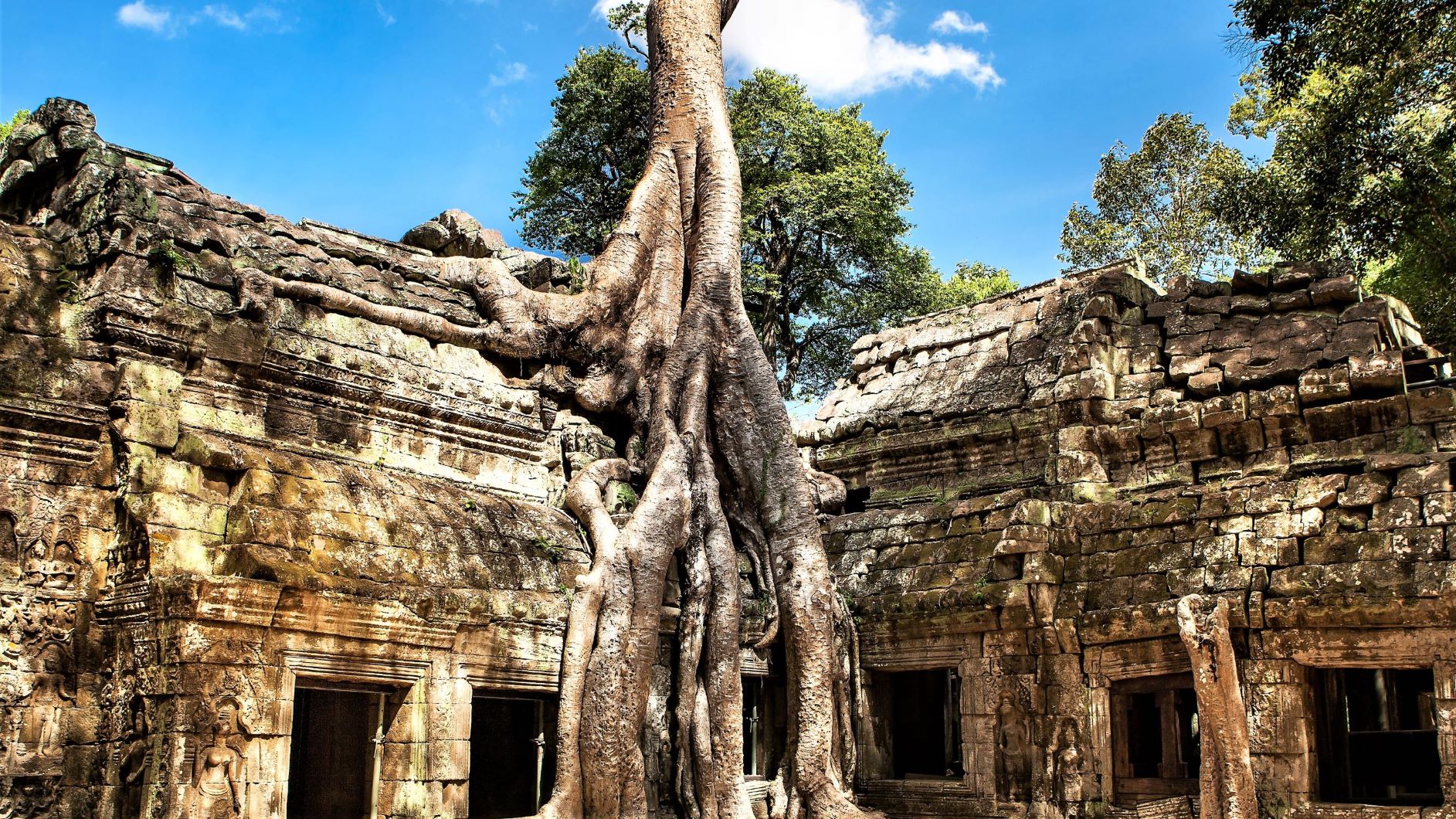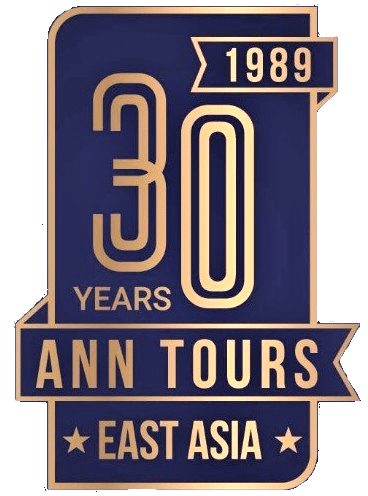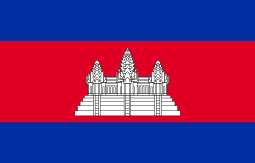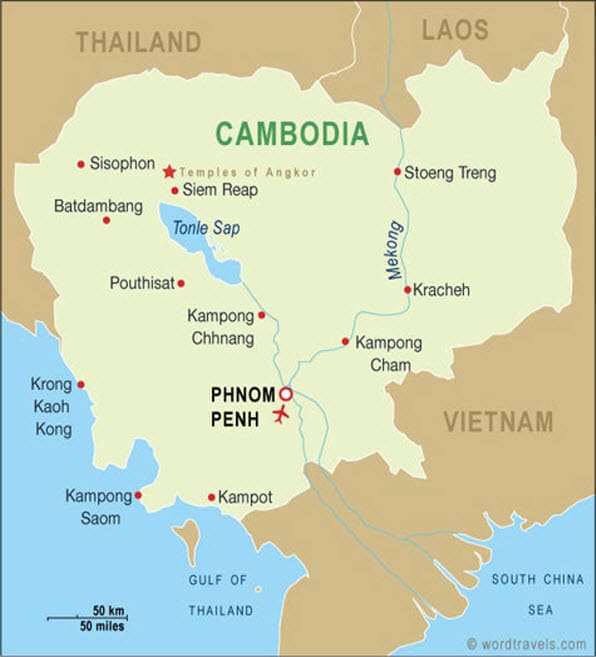


CAMBODIA
GENERAL INFORMATION
For many, the name Cambodia recalls the recent 1970s history of mass genocide. But as with the rest of Southeast Asia, Cambodia is reconciling its past and moving forward at the same time. The nation welcomes more and more visitors each year who come to discover her beautiful present-day culture, as well as that of Cambodia’s great Angkor-Khmer Civilization which existed from 802-1432 AD. While Europe was still in the Dark Ages in 1200 AD, Cambodians were building complex interconnecting cities, irrigation systems, and waterways which gave rise to a population of a million inhabitants at its peak. Lavish monuments and other structures have weathered time and are still in existence, some with nature overgrown around them, and visitors can walk through and appreciate the magnitude of resourcefulness of these gentle people. So, come with us and discover the “Land of Smiles!”
HISTORY AND CULTURE
Mainland Territory: 181,040 sq. km
Population: 16,245,729 (2018 est.)
National Capital: Phnom Penh
International Calling Code: Cambodia: +855
The earliest settlements discovered here date from the 7th century BC. With the end of the Angkor period in the 14th century, and then again with the reign of the Khmer Rouge, much historical documentation was destroyed. Thankfully, we have accounts by foreign traders and architectural remains to tell us one important fact: For a period of approximately six centuries (9th-14th), the Khmer people established at Angkor a base of military and political power coupled with sophisticated culture that was unrivaled in Southeast Asia. The Kingdom of Cambodia is in the southern portion of the Indochina peninsula in Southeast Asia. It is bordered by Thailand to the northwest, Laos to the northeast, Vietnam to the east, and 443 km (275 mi.) of coastline along the Gulf of Thailand to the southwest.
Topography
Central characteristics of Cambodia’s landscape are the Tonle Sap (Great Lake) and the Mekong River delta in a low-lying central plain. The plain meets a sandstone escarpment to the north and is overall surrounded by highlands and small mountains.
Administrative Units
First-level administrative division include 25 provinces and an autonomous municipality. The country’s 159 districts and 26 municipalities form the second level. These are further divided into communes and quarters.
Language
The official language of Cambodia is Khmer, which is also referred to as Cambodian. French and English are widely spoken in hotels and business circles. English is the first language among young students, while French is spoken by the older generation.
Ethnic Groups
Cambodia’s population is primarily Khmer at 98%. Other inhabitants include Chinese, Vietnamese, Cham, and tribal groups including Kreung, Tampuan, Kuoy, and Jarai.
VISA
For most visitors to the Kingdom, visas are obtainable upon arrival at both Phnom Penh and Siem Reap International Airports in Phnom Penh and Siem Reap. At land crossing from Thailand, visas are available at Poipet Banteay Meanchey and Cham Yeam (Koh Kong province). Visitors who enter from Vietnam through Bavet (VN: Moc Bai) or Ka-Om Samnor (VN: Chao Doc) will need to have already obtained their visas prior to their arrival through a Cambodian Embassy or Consulate overseas. Tourists also can obtain visa through the online E-Visa.
Some nationalities are required to get visa in advance at Royal Embassy of Kingdom of Cambodia in their country: Afghanistan, Algeria, Arab Saudi, Bangladesh, Iran, Iraq, Pakistan, Sri Lanka, Sudan, Nigeria.
A passport and visa are required. Tourists and business travelers may purchase a Cambodian visa valid for one month at the airports in Phnom Penh and Siem Reap and borders. Both require a passport valid for at least six (6) months from the expiry date, 01 recent passport-sized photo. A departure tax is charged on all domestic and international flights.
Airport Tax (Passenger Service Charges):
For International Travel
Foreigner:
Adult US $25
Under 12 years old US $13
Under 2 years old FREE
Cambodian:
Adult US$18
Under 12 years old US $10
Under 2 years old FREE
For Domestic Travel
Foreigner:
Adult US $6
Under 2 years old FREE
Cambodian:
Adult US $5
Under 2 years old FREE
The entry points to obtain Visa:
Airports:
• Phnom Penh International Airport
• Siem Reap International Airport
Cambodia-Vietnam border:
• Bavet International Check Point (Svay Rieng Province)
• Kha Orm Sam Nor International Check Point (Kandal Province)
• Koh Rohka International Check Point (Prey Veng Province)
• Banteay Chakrey International Check Point (Preyveng Province)
• Tropeang Sre International Check Point (Kratie Province)
• Prek Chak International Check Point (Kampot Province)
• Phnom Den International Check Point (Takeo Province)
• Oyadav International Check Point (Rattankiri Province)
• Tropieng Phlong International Check Point (Kampong Cham Province)
Cambodia-Thailand border:
• Cham Yeam International Check Point (Koh Kong Province)
• Poi Pet International Check Point (Banteay Meanchey Province)
• Osmach International Check Point (Odor Meanchey Province)
• Sihanoukville International Check Point (Sihanoukville Province)
• Choam Sanguam International Check Point (Banteay Meanchey Province)
• Prum International Check Point (Pailin Province)
• Doung International Check Point (Battambang Province)
• Preah Vihear International Check Point (Preah Vihear Province)
Cambodia-Lao border:
• Dong Krolar International Check Point (Steung Treng Province)
• Tropieng Kreal International Check Point (Stung Treng Province)
It is required for the visa applicants to submit passport, application forms, a recent passport-style color photograph, and such other documents as determined by the status of stay.
VISA FEES:
• Single entry visa fee for tourist (T) (30 days): US $30
• Single entry visa fee for business (E) (30 days): US $35
TOURIST & BUSINESS VISAS
• Visitors from countries not under Visa Exemption Agreements must apply for a Tourists (T) or business (E) visa valid for one month at the points of entry. You can apply right on arrival with a passport size picture for most nationalities(there are some exceptions so make sure you check with the embassy if you are required to get a visa prior to your arrival). To save time lining up to get your visa on arrival you can go to the official government website to get your electronic visa: https://www.evisa.gov.kh/
• Visa K can be issued to a Cambodian national entering the Kingdom on a foreign passport. (The applicant must provide well-documented evidence, such as proof that one’s parents were Cambodian).
VISA EXEMPTION (ASEAN NATIONS):
The nationals of the Laos, Malaysia, Philippines, Singapore, Vietnam, Thailand, Indonesia, Brunei Darussalam, Myanmar do not need a tourist visa and may stay in Cambodia for 21 and 30 days respectively.
VISA EXTENSION:
The tourist (T) and business (E) visas can be extended at the Immigration Department, National Police. The Diplomatic (A), Official (B) and Courtesy (C) visas can be extended at the Consular Department, Ministry of Foreign Affairs. A tourist visa can be extended only once for up to one month (single entry).
A business visa can be extended for:
• One month (Single entry)
• Three months (Single entry)
• Six months (Multiple entry)
• One year (Multiple entry)
• Overstayers will be fined US $10 per day.
WEATHER & HOLIDAYS
Climate
Cambodia lies in the tropical zone. There are two seasons: monsoon and dry. The humid, rainy season lasts from April to October, when temperatures reach 32°C/90°F. the hottest month is April, when the temperature can reach 38°C/100°F or hotter. The cool, dry season lasts from November to March, with temperatures reaching 27°/80°F.
Holidays and Festivals
The dates of traditional Cambodian festivals are set according to the Khmer lunar calendar.
• Mid-April: Chaul Chnam Thmei (Khmer New Year) – one of the two most important holidays
• Mid-November: Water Festival – the second of the two most important Cambodian holidays. The Mekong Pirogue races take place at this time. The last three days are held in Phnom Penh in front of the Royal Palace.
• November 9: Independence Day
Food
As in the rest of Southeast Asia, rice is a staple grain, with fish from the Tonle Sap (Great Lake) and Mekong River an important protein source. Cambodian cuisine includes tropical fruits, soups and noodles. Common ingredients include kaffir lime, lemon grass, garlic, fish sauce, soy sauce, curry, tamarind, ginger, oyster sauce, coconut milk, and black pepper. For the adventurous, try some of the local street delicacies, such as fried spider. The French influence holds steady with the baguette as an important element of Cambodian cuisine.
Internet
Cambodia has many internet cafes in the cities, with approximately 300 in Phnom Penh alone. Internet connection is fairly reliable, and costs around US $.76/hour. Wi-Fi is also available in many restaurants, coffee shops, and hotel lobbies.
Health
Travelers are advised to be up-to-date on tetanus, typhoid, and polio immunizations.
A brief checklist:
• Consider taking water purification tablets with you.
• Take insect repellent with DEET. You may want to consult your physician on proper medication to take for malaria.
• Mosquito netting is always suggested when sleeping.
Bottled water is widely available. All other water should be regarded as possibly contaminated. Water for drinking, brushing teeth or making ice should first be boiled or otherwise sterilized. Milk is unpasteurized and should be boiled. Powdered or canned milk is available and is advised. Avoid dairy products which are likely to have been made from unboiled milk. Only eat well-cooked meat and fish. Vegetables should be cooked, and fruit peeled.
BRINGING MONEY
Currency, Banking, and Credit Cards
The official currency of Cambodia is the Riel, but US dollars are widely accepted. Most hotels accept international credit cards such as Visa and Mastercard. Traveler’s checks are not as widely accepted, so it is advised that you use a combination of US dollars, Riel, and credit cards.
Shopping
Cambodia offers a wide range of handicrafts, such as beautiful silverware, potter, and jewelry. Religious themes and scenes of daily life feature strongly in oil paintings and intricate carvings made from sandstone, marble, and some of Cambodia’s tropical hardwoods. Perhaps most attractive to visitors is the wide range of traditional silk and cotton cloths which can be made into fine clothing by local tailors at a low cost. In true Asian tradition, open marketplaces are an integral part of Cambodian life. These markets sell everything from mainstream and exotic foods, and clothes, including krama, the multi-purpose scarf worn by many Cambodians. Even for non-shoppers, the markets offer a fascinating glimpse of Cambodian daily life and culture.
Electricity
220 volts, 50 Hz. Power outlets are two-prong round or flat sockets. Adaptors are recommended and may be purchased on Amazon or at your local travel or electronics store.
DO'S & DON'TS
Local Etiquette
Do’s
• Greet Cambodians as they greet you. Handshakes and physical contact in public is not an accepted norm, especially between a man and a woman.
• Ask for permission before taking photos of others.
• Remove hats and shoes before entering a Khmer home or pagodas.
• Learn some basic words in Khmer, such as “Hello” and “Thank you.” A good online resource can be found here.
• If you have an opportunity, stay overnight with a Khmer family. This is a great way to experience local culture.
• Try local foods such as Amok and Num Bachok.
• Visit a local market in the morning to experience the daily life of locals.
• Take in a cultural dance performance available in any number of restaurants.
• Bargain when making purchases in the markets. This can be an enjoyable way of interacting with locals.
• Support local merchants by purchasing souvenirs to take home.
Don’ts
• Don’t engage in public displays of affection.
• Don’t wear revealing clothing when entering temples or other places of worship.
• Don’t purchase historical artifacts in Cambodia, as it is illegal. Buy replicas only.
• Don’t take home pieces of stone from temples or other tourist sites no matter how small and plain they may appear.
• Don’t touch people on the head. The head is considered holy.
• Don’t point or gesture with your feet or put them on furniture, as it is considered very disrespectful to do so.
• Don’t give candy to children who are vendors in temples unless you intend to buy their products.
• Don’t use foul language while on a body of water or in the jungle. It is considered a bad omen.
• Don’t criticize or make negative comments about the Royal family.
• Do not consume narcotics or engage in sexual exploitation of children.
PACKING LIST
A packing list is often a forgotten part of the planning processes, but it’s one of the most important steps to ensure an enjoyable vacation. Here are some important reminders from our traveler’s experiences:
Documentation:
• Your passport should have at least 6-months validity from the date of departure on your trip.
• Check your visa requirement to your destination. Check the entry date on your visa and validity of the visa.
• When possible book e-tickets. If you happen to lose your ticket you can always print your ticket online.
• Always make extra copies of your passport and keep it separate from your original.
• Make a copy of your travel insurance and emergency contact information. It’s best to have those numbers entered in your mobile phone.
• Call your credit card company to inform them of the dates of your trip so that your charge card won’t get blocked by your card company because of a foreign charge. This will also protect you in the event your card is stolen, and you have fraudulent charges on your account. Visa and Mastercard are widely accepted as oppose to Amex.
• Make sure your tour operator knows of any allergies you may have.
Electronics or gadgets:
• If you have a 3-pronged plug, you will need to bring an adapter to change to 2 prongs (flat and round). Most countries will have plugs for 2 prongs.
• Make sure your electronics can take 220 volts as this is standard in most countries.
• Sometimes it’s a good investment to bring a backup mobile phone where you can use a local SIM card for calls. It’s much cheaper than using your regular mobile phone and paying for roaming calls.
• Don’t forget your charger for your electronics and check to see if they are compatible with 220 volts.
• Bring small pocket solar calculator to convert exchange rates.
Clothing & Miscellaneous:
• Know where you are traveling and the weather you should expect. Traveling to a tropical area you will expect to see mosquitoes, so bring some long sleeve shirts and long pants for evenings.
• Traveling to Asia it is frowned upon to wear shorts that are 6 in. above the knee, especially when visiting temples or places of worship. Wearing a dress is fine if you plan to dress light. But again, when visiting temples please make sure dresses are no more than a few inches above the knee with a shirt or blouse covering your shoulder. Revealing shoulders are frowned upon.
• Good walking shoes and socks
• Slip-on shoes for ease of taking them on and off when visiting pagodas, houses, and other places where footwear in inappropriate.
• Rain-resistant light jacket
• Head cover to protect from hot tropical weather
• Sunscreen
• Insect repellent with DEET
• Stomach medicine
• Prescription medication
• A good book for those occasional flight delays
TIPPING
Tipping in Cambodia is not expected, but it is appreciated. The following are some basic guidelines: In restaurants, 10% is considered fair. There is no need to tip at food stalls. For hotel staff, tuk tuk or moto drivers, and on-location tour guides, a couple of dollars for good service is appreciated. When visiting temples, if someone shows you around or if a monk offers a blessing, consider looking for the donation basket that’s usually near the entrance.
CANCELLATION POLICY
Before 45 days, no charge tours.
45 to 30 days prior arrival date: 5% of the total price
29 to 15 days prior arrival date: 10% of the total price
7 days to the day of arrival: 50%
3 days to the day of arrival: 100%



